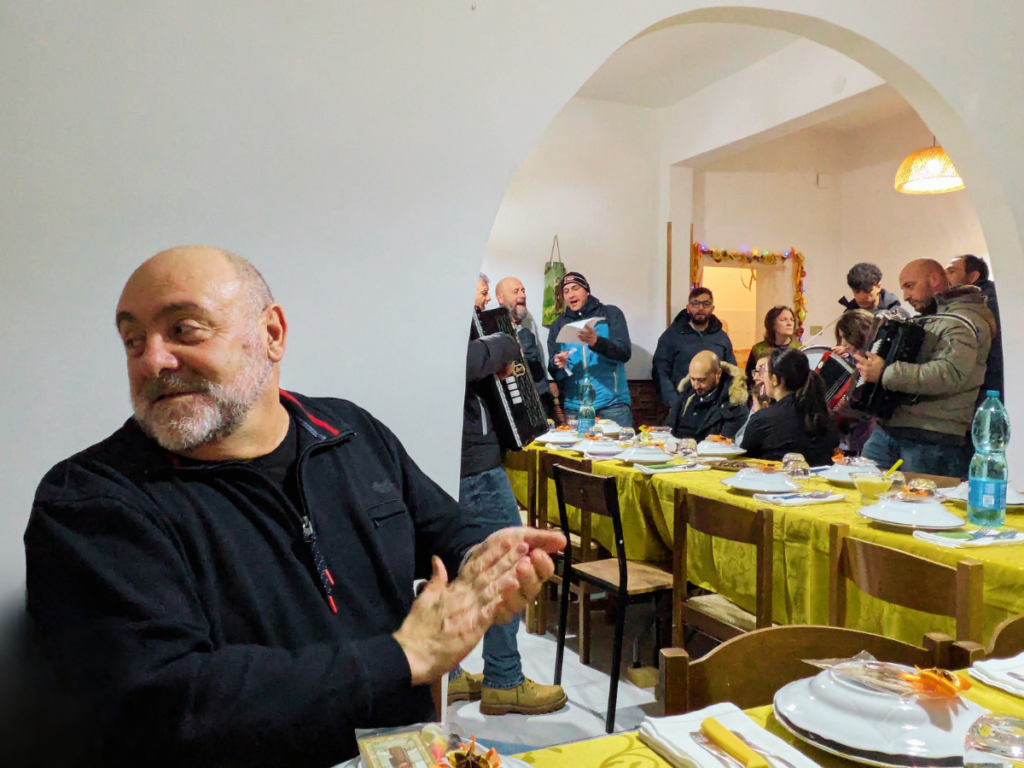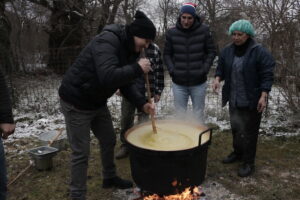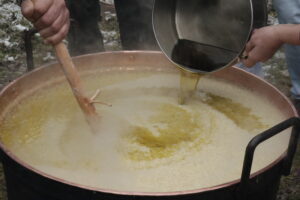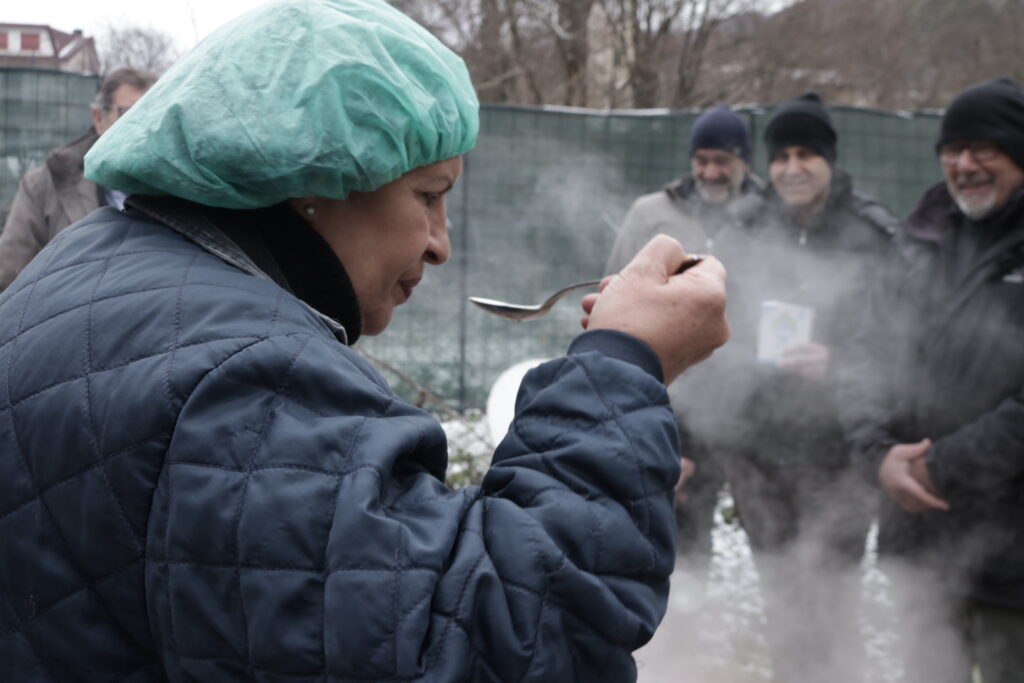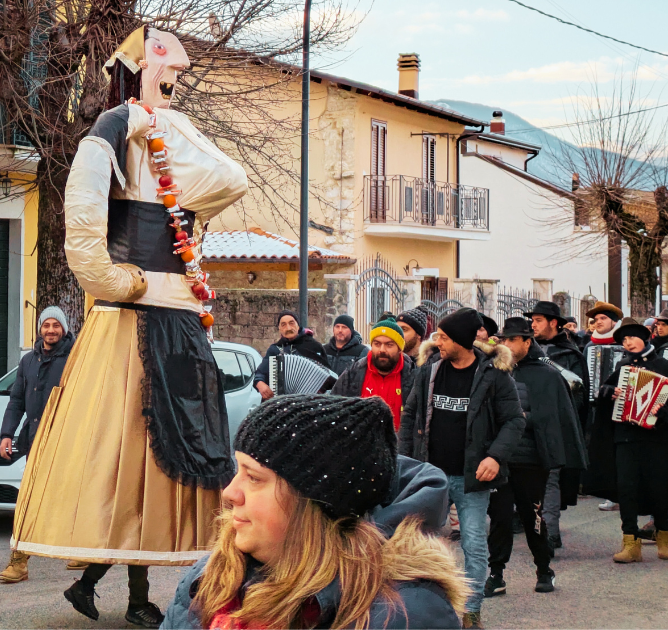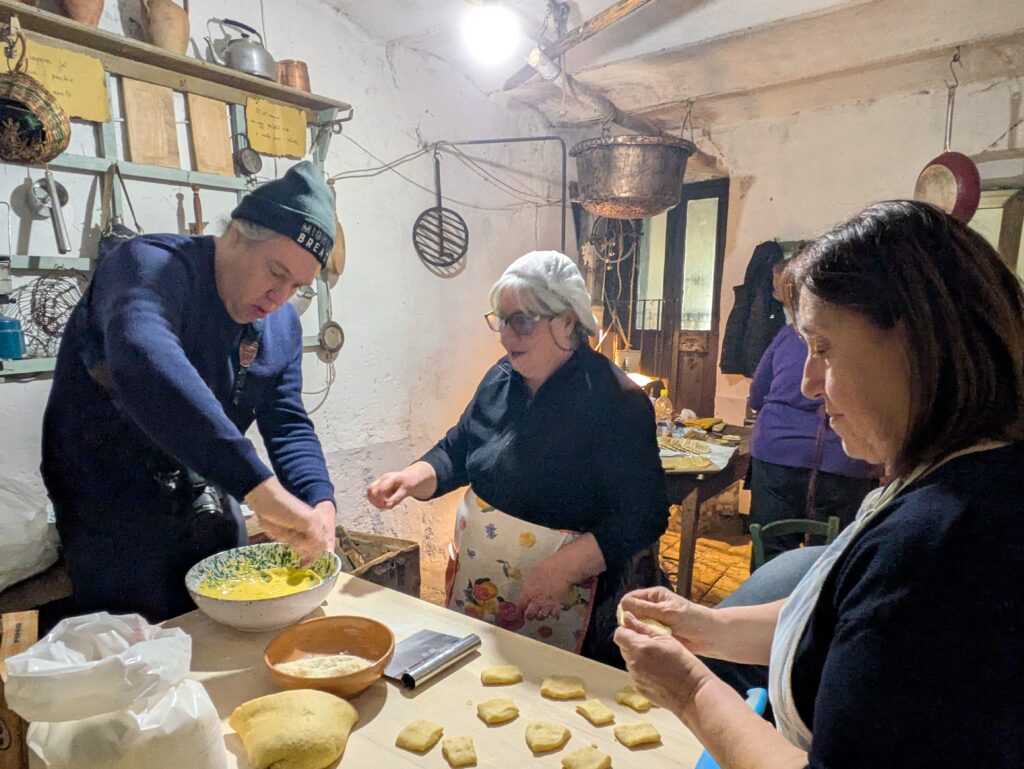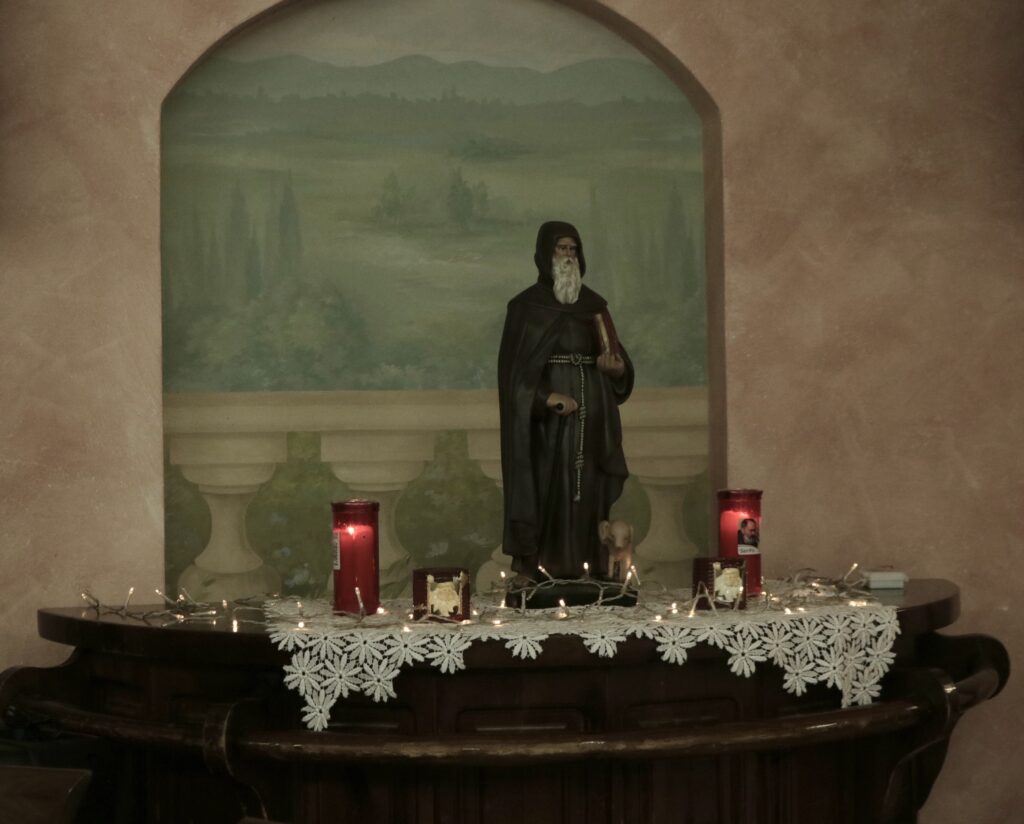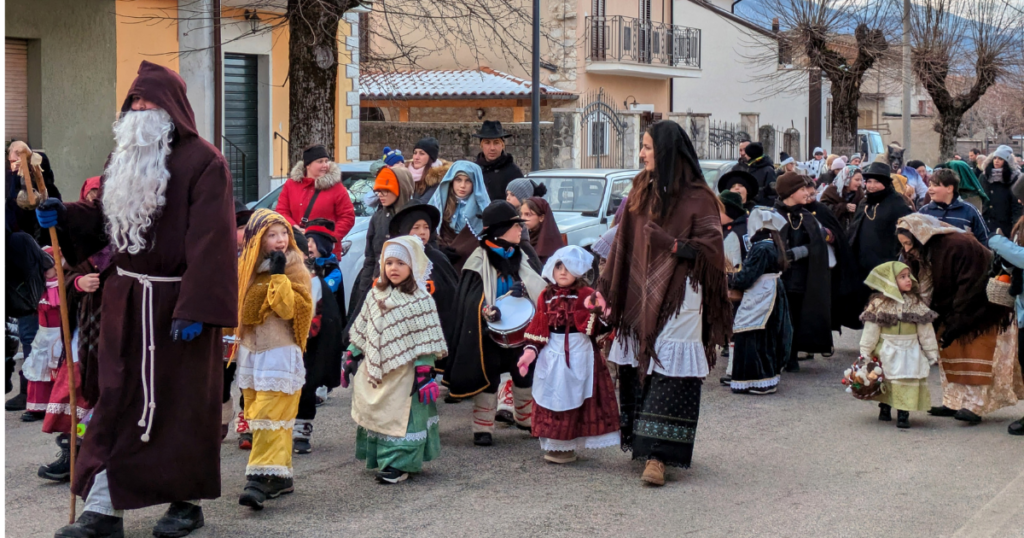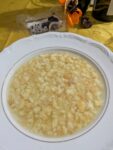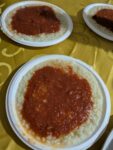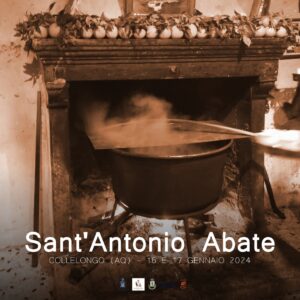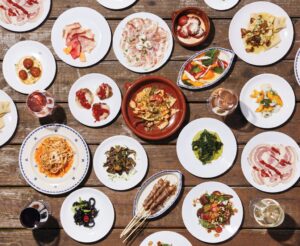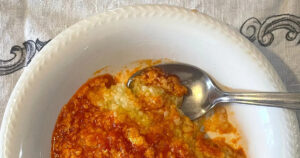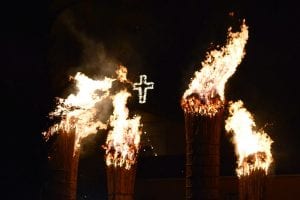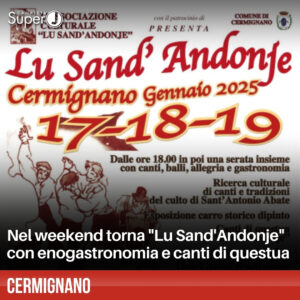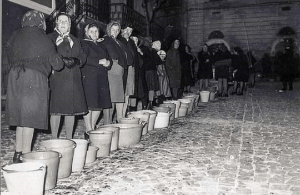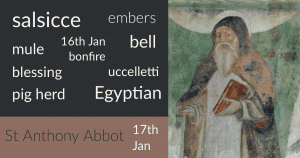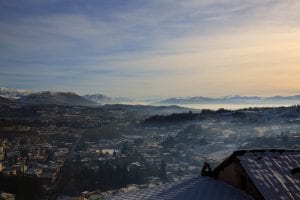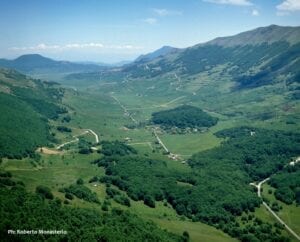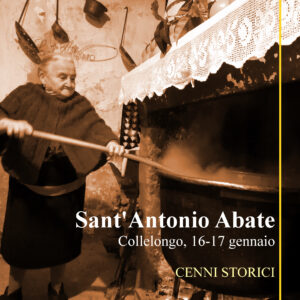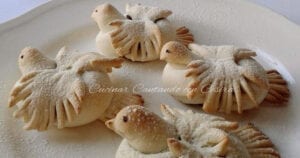Villavallelonga is a town of about 900 souls in Abruzzo’s southwest, the Marsica territory, just across the border from Lazio and outside the oldest of Abruzzo’s three national parks, Il Parco Nazionale d’Abruzzo, Lazio e Molise. You don’t end up in Villavallelonga by accident. At the end of a barely two-lane, rural road, fenced in on three sides by mountains in a natural cul-de-sac, “Villa” (as locals refer to it) feels remote. As the crow flies, it’s a short distance from both Sora (in Lazio), and Pescasseroli, the park’s principal settlement. But no roads connect either to Villa. If you’re game, Pescasseroli would be about a five-hour hike over the mountains south of town. The road enters Villa at its newest section, built after the 1915 earthquake that killed over 30,000 in the Marsica, and rises gradually to the medieval borgo, a tangle of alleys and steep climbs lined by stone houses. On the hill’s crest, there’s an ample piazza to the right with two bars. Much of the town’s quotidian social interaction happens there. Parts of the borgo are in disrepair and ruin. The mass emigration that afflicted most of Abruzzo was especially hard on Villa. The town’s highest point retains the foundations of homes levelled by the earthquake, and the space once occupied by the chiesa madre destroyed by it has been preserved and marked. There’s that wistful beauty one finds in many Abruzzese towns. History is ever-present. But it doesn’t oppress. It seems, instead, to inspire. Most of the borgo remains intact and, even with so tiny a population, buzzing with life. The inhabited houses and properties are handsome, even beautiful. It’s a proud place.
We came to Villavallelonga by invitation of its thrice-elected Mayor Leonardo Lippa, and Vice Mayor Vittoria Di Ponzio. They’d visited us at Le Virtù, our Abruzzo-inspired restaurant in South Philly, early in summer 2024, and had been loosely following the restaurant since news of our Panarda, a pantagruelian multi-course feast particular to Abruzzo, reached them via a 2013 Washington Post article written by Italian cuisine expert Domenica Marchetti (whose mother was from Chieti, in Abruzzo); that was our third iteration of the feast. While the Panarda was once diffuse in Abruzzo (examples are still held in Lanciano during the “Mastrogiurato” and occasionally in Sulmona as part of the annual “Giostra” events), it’s most felt in and associated with Villavallelonga, the site of the oldest recorded version (but certainly not the first), held in 1657. Villa’s Panarda comes in January, at the end of the week celebrating Sant’Antonio Abate, protector of butchers, animals, farmers, the harvest, etc. Stuff that matters in the hinterlands.
We’d based our Panarda on one thrown by the Abruzzese poet, Italian irredentist, and notorious check-dodging libertine, Gabriele D’Annuzio and his artist friends. Theirs was an exercise in excess, with over 40 dishes served. A cannon shot supposedly announced each course, and men armed with shotguns enforced a clean-plate policy. Who knows if that’s true? For D’Annunzio, it tracks. The “Scuola Alberghiera” in Villa Santa Maria and Cantina Frentana (a wine cooperative in Chieti province) had produced a menu celebrating that event, which they’d published in a small booklet. We’ve used it as a road map, allowing for a few deviations within la cucina abruzzese. And why? Initially, most likely out of arrogance and a desire to show off, to prove we could do it, and generate attention. And then because something occult seemed to happen at each Panarda. Over the course of the nearly nine-hour feasts, the walls between people disappeared, and conviviality became a specific community. Le Virtù actually felt like Abruzzo, which was our original goal. Domenica Marchetti’s piece captured some of that, but it also, most importantly, spoke of Villavallelonga’s tradition. And that experience became our elusive, seemingly unobtainable objective.
At our South Philly summer dinner, the Mayor Leonardo and Vice Mayor Vittoria described Villavallelonga, and asked about our own Panarda. We quickly established an easy rapport; these were down-to-earth people who spoke openly and frankly about their town and its traditions, and the culture of Sant’Antonio Abate. They suggested that there might be something more for us to experience in Villa, something more profound. And they invited us not only to attend their next Panarda but also to whet our appetites and experience their August culinary festival, Le Terrate Aperte (“the open terraces”). At twenty different stands in the borgo, folks prepare and serve traditional dishes; it offered us the opportunity for a deep dive into the local cuisine, unadulterated recipes difficult to find anywhere else. My wife Cathy (the other co-owner of Le Virtù) and I were in. We arranged to spend both nights of the festival in Villa as the town’s guests, and Vittoria would put us up in a simple, unoccupied home in centro.
Our First Visit to Villavallelonga (August 2024)
When we arrived, the town was swarming with humanity. Villa’s population swells to three or four times its normal size during this part of the summer. “Villavallelonghesi” who’ve emigrated, along with their children and grandchildren, return from all over the globe, but principally from Toronto and Rochester, New York. It felt like an enormous and happy family reunion, and we were welcomed with open arms. Over the course of the festival, we talked at length with Vittoria about the town’s challenges and culture, spent time with her family, and ate an unconscionable amount of insanely delicious and hardcore Abruzzese food. Polenta with sausage, i frascaréglie (a granular flour and egg pasta whose cooked consistency is somewhere between couscous and polenta, and dressed with a rich meat sugo), i maccarune i Sant’Antonie (a chitarra-like pasta served with lamb sugo), l’acquacotta (pork belly, sausage, egg, onion, and chunks of rustic bread in broth), fagioli con le cotiche (bean and pork-rind soup), pasta all’ortica con salsiccia (trofie-like pasta with nettle tops and pork sausage), etc., etc. We crawled into bed after midnight on both nights, but the little town hummed until the wee hours. I awoke at 4 am on the second night to “Brigante Se More” (a song celebrating southerners who, for nearly nine years starting in 1861, fought a guerrilla war resisting unification under Piemontese rule) being played and sung with gusto by a group of young people just below our bedroom window. As I noted, history is present in Villa. Cathy and I were rapt.
January 2025, La Festa di Sant’Antonio Abate
We were an excited threesome – Chef Andrew Wood, Cathy, and I – as we navigated the road to Villa on a cold, cloudy January 12th morning. For its feeling of remoteness, the town is just over a half-hour drive from Avezzano, a comparatively modern city (also entirely destroyed in the 1915 earthquake) of just over 40,000. We based in Avezzano, as Villa lacked the accommodations to host all three of us. The road crosses the Fucino, the dry lake bed (drained first by the Emperor Claudius and then again, after the unification of Italy, in the 1870s), now one of Italy’s most fertile agricultural plains. Unlike most of the other towns clustered along the perimeter of the former lake, Villa’s economy never centred around fishing or working the rich, flat Fucino. Villa, like much of Abruzzo, was deeply rooted in the pastoral tradition. As we climbed from the basin, the terrain became rougher. The mountains rising on either side of the road were dusted with fresh snow.
Our first stop before meeting Vittoria was at Bar Bianchi, in the main square. Cathy and I were recognised from August, and we weren’t permitted to pay for our coffees. While we caught up with the locals, folks arrived with buckets filled with fava bean soup, known locally as la favata. Simple, rich, and filling. During the festival, this soup is distributed across town. Everyone in the bar was given a plastic bowl and a piece of bread – there was no charge. Fava beans loom large in Villa’s culture: once believed to have medicinal properties, fave had once been fed to the animals to ward off disease. The mayor stopped by and stood us another round of coffee, and Vittoria arrived to begin our immersion. As we left the bar, another group arrived with more bread and favata.
Vittoria walked us to a small clearing just outside of the borgo. A lone, battered, iron cauldron sat on a wood fire, tended to by a group of men in worn winter clothing. They invited Chef Andrew to come over and take some photos. A large white cow, possibly a Marchigiana breed, walked back and forth, visible in the naked trees beyond the clearing. Vittoria led us inside a nearby building where there was a large dining room set for service. Several women moved quickly and purposefully about the space, to prepare the frescaréglie. There was an enormous basket of pasta – each granule a fraction of the size of a pea – in the middle of the room, just beneath a statue of Sant’Antonio. Vittoria promised us a lesson on how this pasta was made. The men outside brought the water to a boil. One woman (obviously the boss) in a blue head scarf took charge from there, salting the water to taste, dropping the pasta, and overseeing the stirring pattern, which she serially corrected, much to the men’s amusement. At the woman’s command, a massive amount of olive oil was poured into the mix. The dense, thickening mixture was churned with a long stick with short protrusions, obviously fashioned from a tree branch (also used in cheesemaking). While it cooked, other women set up a table with condiments: a pot of pork sugo, and bowls of grated pecorino and parmigiano. A line of townspeople began to form, with everyone holding a container. One by one, we were all served from the pot, and then carried our portion to the table to be dressed. This same ritual was going on in other parts of town, assuring that everyone would get their share, with no money exchanged. In much of Abruzzo, parmigiano cheese is a somewhat recent development, so I opted for the local pecorino. We carried our dishes to Vittoria’s home, where she uncorked cerasuolo and Montepulciano d’Abruzzo wines. Her husband Angelo cut up salumi and pecorino, as Vittoria’s son emerged, sleepy-eyed but smiling. He’d been up late the previous night, playing with one of the groups of musicians who paraded through Villa during the week. Music is everywhere during the festival. He greeted us, picked up his accordion, and left to join his bandmates.
We learned that this sort of activity – food communally prepared and distributed – was a principal feature of the festival. Along with the parades and processions, there would be a number of occasions to dine al fresco at the townspeople’s largesse. The night after the frascaréglie, local Alpini veterans (Abruzzo was a natural recruiting spot for mountain troops) made pasta all’amatriciana (which most Abruzzese will tell you is a regional dish, and not Roman) outside, in the newer part of town. The next night it was sagne e ceci further up the main road in the borgo. And so forth: a bowl of pasta, wine (often poured from a large box), and even digestive (typically genziana), all consumed fireside. Again, no money changing hands, and everywhere a feeling of togetherness.
On January 15th, the day before the Panarda, there was a parade. Music, people in local costume, others dressed as wolves, devils, and evil spirits, all representing the challenges faced by Sant’Antonio. Children were decked out in traditional women’s dress or as shepherds. The men dressed as evil spirits (i mmascar’ bbrutt) playfully menaced the children (and me) along the route. There were also huge papier-mache figures, la pupazze(known in Villa as “La Segnora”), and the figure of an Alpino with a knife in his eye (no one could explain the knife, but suggested it was an inside joke; the “segnora” was a constant, but the other figure changed every year). The crowd sang the Sant’Antonio song (if you stay more than 30 minutes in town during the festival, this song will embed in your memory; it still features in my dreams) and walked a circuit through town before filing into the primary school for an assembly. During the walk, an officer from the Parco Nazionale (serving as unnecessary security) asked where we were from (as far as I knew, we were the only non-locals present). We talked for a while, he offered me a cigarette (I declined) and waxed about what the festival meant to him. He was in his early 60’s, born in Villa, and – like everyone we’d met – fiercely proud and connected to the place. “This is a religious festival, true,” he said. “But mostly, this is about solidarity.” After the procession, I walked to the ruins of houses destroyed in the earthquake. A group of costumed young people were gathered there, munching on salumi and pecorino, and drinking Montepulciano from a box. A young man dressed as the devil handed me a plastic cup. They were all born in Villa, but later forced by economic work realities to leave: some had gone to Roma, others to Milano, and some others elsewhere in Europe. But they returned every year for Sant’Antonio. “Villa’s in our DNA,” said the devil. I asked a young woman in her early twenties, with a shock of chestnut, pre-Raphaelite hair spilling from under her headdress, what this festival meant to her. “Communità,” she said without hesitation. “Solidarity. Here, we depend on each other to survive. We take care of each other. It’s important, no?”
That night, the “Proloco Villavallelonga” hosted us for a cooking lesson. We filed upstairs into a kitchen that, beyond a 1960s-era stove, hadn’t changed much since the 19th century. The space, roughly three by six meters, would have been the common room in the centuries-old house, filled with implements and decor from distant times, a sort of museum of the town’s traditional life. The three of us, Vittoria, and six local women and one man crowded in by a roaring fire that warmed the room. We were taught the recipes and prep for frascaréglie, ferratelle (known elsewhere in Abruzzo as pizzelle or, around Penne, neole, and pasta bignè (chicken broth, diced “beignet,” pecorino, and egg drops). One of the women, clearly the leader, ran a tight ship and kept things in order, but the atmosphere was joyful. There was friendly patter, joking, laughter, and love: the pleasure of working together and the desire to share was obvious, and the generosity extended to us nearly overwhelming. As with almost every moment spent there, we could feel Villa’s pride, a benevolent, gracious brand of it, completely devoid of arrogance. Chef Andrew got his hands dirty, earning the collective approval of the teaching staff. Genziana was poured. The boss lady looked at me and winked. At one point, a group of children aged 6 to 16 came and crowded into the room to sing the Sant’Antonio song (children go door-to-door for treats and coins during this week). As we left, Chef Andrew asked me to say something to the group as a thank-you. He was almost without words, and patted his chest above the heart. They understood.
La Panarda, The Day of the Feast
January 16th, the day of the Panarda, started in late afternoon with a procession of the statue of Sant’Antonio. It climbed up through town with musical accompaniment to the Madonna delle Grazie church, with most of Villa’s population trailing behind and singing the Sant’Antonio song. Some of the older folks, who could no longer make the walk, watched from balconies and doorways. Many of the girls and children carried a corona di Sant’Antonio (“crown of Saint Anthony”), a string of ferratelle, dried figs, fava beans, chestnuts, oranges, apples, and other sweets. The crowns had been prepared in the days leading up to the 16th, and we’d seen them during the week in nearly every house and space we’d entered (they were even hung in the stalls of the animals). Others carried baskets with fruit, bread, pasta, etc. The huge papier-mache female figure of La Segnora (animated from inside by a series of men who took turns), spun around the piazza in a wild dance. There were evocations of the stories behind the Panarda, reenactments in local dialect, with young people in the major roles. Traditionally, only members of the Bianchi and Serafini clans are permitted to host a Panarda. There would be dozens of individual Panardas in Villa that night, assuring that everyone would be included, but every host could trace their bloodline to one of the two families. The Serafini family can claim the oldest recorded gathering in 1657, their tradition based on a legend where the landowner Serafini was having trouble finding workers for his fields and lamented that he’d have to get the devil to work them. The next day a strange figure offered to work the fields with his associates and asked only for a meal made without salt. Serafini returned home to ask his wife to make the meal but forgot the salt prohibition. When she brought their food out, the workers reacted in disgust. She was shocked, asking how they could eat without salt (a question many a restaurateur has asked themselves over the following centuries). Were they, perhaps…devils? At these words, the crew disappeared into the ground, leaving only the stench of sulfur. The satanic pact being voided, Serafini’s wife fell to her knees and promised Sant’Antonio all of the harvest as thanks. The Bianchis’ legend might sound familiar to those with knowledge of Abruzzo: a wolf snatches a baby from its cradle, and the desperate mother begs for and receives Sant’Antonio’s intervention (this corresponds to similar rescues elsewhere in Abruzzo), so promising the feast in perpetuity.
After the procession, we walked around town for a bit, trying to build an appetite; it was quite cold. Vittoria invited us back to her house to kill some time, where we chewed the proverbial fat with her husband and daughter. Mayor Lippa called at 8pm to say they were ready to begin the Panarda. We were almost hungry.
We entered a warmly lit home in the newer part of town, where this Panarda was hosted by Mayor Lippa’s mother-in-law. The communal table, arranged in a long, backward “Z” configuration to fit the space, had been set for around thirty (including extra seats for unexpected guests). One can’t purchase a ticket to a Panarda in Villa, you must be invited, and once you attend, it’s assumed that you’ll return every year. And you can’t “shop” Panardas, going to one house one year, and another the next. Mayor Lippa hugged us and loudly introduced us to the room. Drinking and singing had already begun. We were greeted warmly and with no small amount of interest: here were the Americans who threw their own Panarda – let’s test their mettle. A group of ragazzi (young men) at the table implored us to toast with them. These men, I can now say with certainty, were devils. The tables were set with liver sausage, prosciutto, capocollo, other salumi and, of course, local pecorino. The mayor sat across from us and jovially guided us through the meal: we didn’t have to finish everything, but we should taste every item – and no, there was no numerical obsession regarding the number of dishes (that wasn’t part of Villa’s culture). But there were many dishes, I can assure you, maybe close to thirty. First to arrive was la favata, and then, in steady rhythm, le frascaréglie, pasta bigne’, and i maccarune i Sant’Antonie. There followed boiled chicken and greens (used to make the brodo), roast turkey, tomato-braised lamb and sausage, and traditional dolci to finish. Toast followed toast with much Cerasuolo and Montepulciano. The devil fiends at the table had also brought some of their own homemade plonk in large plastic jugs. Groups of musicians and costumed figures appeared to sing the Sant’Antonio song, have a nosh or a belt, and wish the diners well. The minutes turned to hours, and if any walls between us and the Villavallelonghesi had stood for five days, they certainly crumbled that night. We took our leave just before 2 am, after the requisite round of digestivi (genziana and ratafia). As we closed the door behind us, we heard the music start up again. We drove back to Avezzano along the dark, snowy road.
The night doesn’t really end for the Bianchi family: at around 5 am, they prepare more favata, and at 8 am go house-to-house distributing the soup. Should one group pass another on their delivery routes, they exchange favata and bread(an archaic symbol of the earth and human labour). Later that morning there was a mass, another procession, more bread distribution, and a benediction of the animals in the piazza by the church. People brought their dogs (including fine examples of pastore Abruzzese, the large, white, shepherd breed), cats (there was a kitten on a leash), horses, and other farm animals (the days of large herds of sheep in Villa have long passed). Fireworks closed the festivities, signifying the transition to Carnevale. More costumes (related to modern culture, including a float carrying Marvel Universe figures), and La Segnora and L’Alpino, all destined to be burned. The party would continue into the evening; we were happily exhausted, said many goodbyes, and drove back to Avezzano to power-nap and then debrief. On our way out of town, we were briefly blocked by the Carnevale procession making its way up the main drag. We don’t know how they do it.
Right before we left, one of the locals asked what my feelings were about Villavallelonga, the Sant’Antonio celebrations. It was hard finding the right words. But something that struck me on my first visit to Abruzzo, almost thirty years ago in Teramo province, in search of my familial roots, came back to me in an emotional rush. The week in Villa had been like rediscovering something essential, something human of true value that you felt like you’d somehow lost but might have never actually had – if that makes any sense. We’d come to Villavallelonga, three heartsick Americans, not knowing what prescription suited our malady. Yes, we were looking for culinary inspiration, things to shake up our menu, and inform our next Panarda. Yes, we wanted to promote our business. But what we experienced with the gifts we received – examples of humanity, common decency, civility, and generosity – and their effects on us were ineffable.
We can bring many of the dishes we ate in Villavallelonga back to Philly (we can and we will). But the most essential aspects of La Festa di Sant’Antonio and La Panarda, they provide the nourishment we need and – especially now – lack. And that is a much heavier lift and more daunting assignment. We hope to be worthy.

